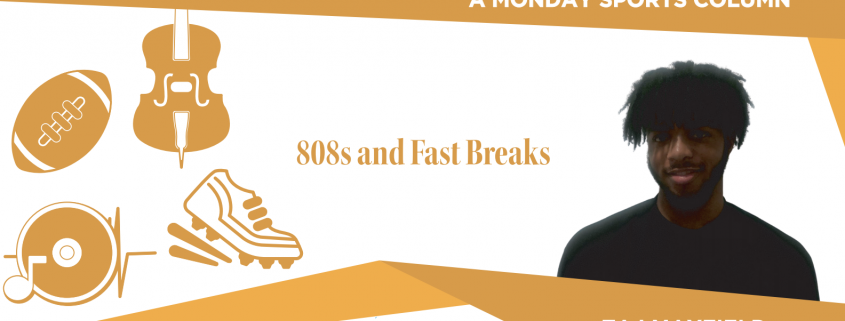808s & Fast Breaks: Women in rap provide hope for women in basketball
The debates really heated up last week. One side continued to spew misinformation and harmful rhetoric, while the other side seemed to have solid intentions, but their past actions made their words fall flat. I usually choose not to waste my energy over things I don’t see changing, but lately, I’ve been thinking: Why can’t things change? Why can’t WNBA players get paid closer to NBA players?
For those who aren’t familiar with the popular social media debate, congratulations. It’s the same every year. Someone posts a shocking statistic like how the NBA’s minimum salary for one non-rookie player is greater than the salary cap of an entire WNBA team or how an all-time WNBA great like Sue Bird only made $215,000 this season while an NBA all-time great like LeBron James made more than that in one half of basketball.
Before I can even certify James’ pay on my calculator, a guy is breaking down what’s wrong with the WNBA’s marketing, another guy is explaining his freshman economics course, another guy is providing a SoundCloud link or two, another makes an unnecessary reach saying WNBA players can play in the NBA and, of course, there’s an assortment of lame, sexist jokes. Like most social media debates, it’s pure chaos.
Fun fact: Before I chose the high-paying field of journalism, I wanted to be a lawyer because of how much I loved debating. One particular aspect I enjoyed was sorting through facts and finding which ones could either make or break my argument. That aspect is front and center in the yearly WNBA pay gap debate. There are truths to every common argument used in the debate, but there are also conflicting facts that break each of those truths.
For starters, the marketing argument is right. WNBA Commissioner Cathy Engelbert said it herself: “We have a marketing problem.” But, as Engelbert would go on to later explain, the league’s marketing problem stems from its restrictive economic landscape. This brings me to the freshman economics guy and his argument of the league not being profitable.
It’s true, the WNBA currently loses money yearly and doesn’t draw anywhere near the number of fans as the NBA, so there’s no feasible way WNBA players can be paid like NBA players. But what the economics guy never points out is that the WNBA doesn’t receive anywhere near the financial or media support that male professional sports leagues receive. As of 2019, all women’s sports combined to receive just 4% of sports media coverage, and despite the WNBA starting one year after the MLS and losing a tenth of the annual money the MLS loses, the average WNBA player makes less than a third of the average MLS player. And with both leagues bringing in nearly identical audiences, what’s the real excuse for the WNBA’s low pay?
It turns out there are truths to the jokes, too. They reveal true, biased feelings toward women. If a person feels inclined to make a kitchen joke after watching a special talent like Sabrina Ionescu do special things like come close to a 30-point triple-double in her second career game, they’re not funny, they’re misogynistic and a major reason why WNBA players don’t get the pay and recognition they deserve. A lot of social media users (I would love to be more specific, but they usually have memes for profile pictures) repeatedly attempt to tear down the accomplishments of some of the most talented basketball players on the planet with sexism disguised as an attempt at comedy.
And for the last of the truths, yes, the WNBA has a salary problem. Even with the financial boosts from the 2020 Collective Bargaining Agreement, there’s still a substantial pay gap between WNBA and NBA players and that’s probably never going to change considering the massive headstart the NBA had. But much like the marketing problem, the salary problem stems from something larger that, unlike the marketing and salary problems, can change right away.
The WNBA has a respect problem, and the current rap landscape provides hope that it can be fixed.
It wasn’t long ago that women in rap had their own respect issue. The genre was deemed misogynistic, women were used as props in many rap groups and special talents were never allowed to coexist. Megan thee Stallion explained the last point best: “Us women have always been talented. But it was a thing where there could only be one woman [rapper] at a time.”
With 11 different entries from five different women making the Billboard Year-End Hot 100 chart, 2019 saw women finally get the respect they deserve in rap, and that respect isn’t going anywhere anytime soon. With mainstream artists like Cardi B, Nicki Minaj and Megan; lyricists like Little Simz, No Name and Rapsody; and indescribable artists like Doja Cat, Rico Nasty and Tierra Whack, women in rap are as diverse and plentiful as ever, and they’re bringing just as many fans to the genre as men.
If fans of a genre as historically misogynistic as rap can rapidly embrace women like never before, what’s stopping fans of arguably the most progressive sport in the world from doing the same? Just like bars from Rapsody don’t have to sound like bars from Kendrick Lamar for rap fans to notice they’re special, Breonna Stewart shouldn’t have to play above the rim for basketball fans to appreciate her greatness.
WNBA superstars like Stewart may never get paid like NBA superstars, but they’ve more than earned equal respect. And, who knows, if the Stewarts and Ionescus of today get that respect, maybe the next generation of WNBA superstars can close the pay gap and end the yearly debate.
Taj Mayfield is a junior writing about the connections between music and sports. His column, “808s & Fast Breaks,” runs every other Monday.

